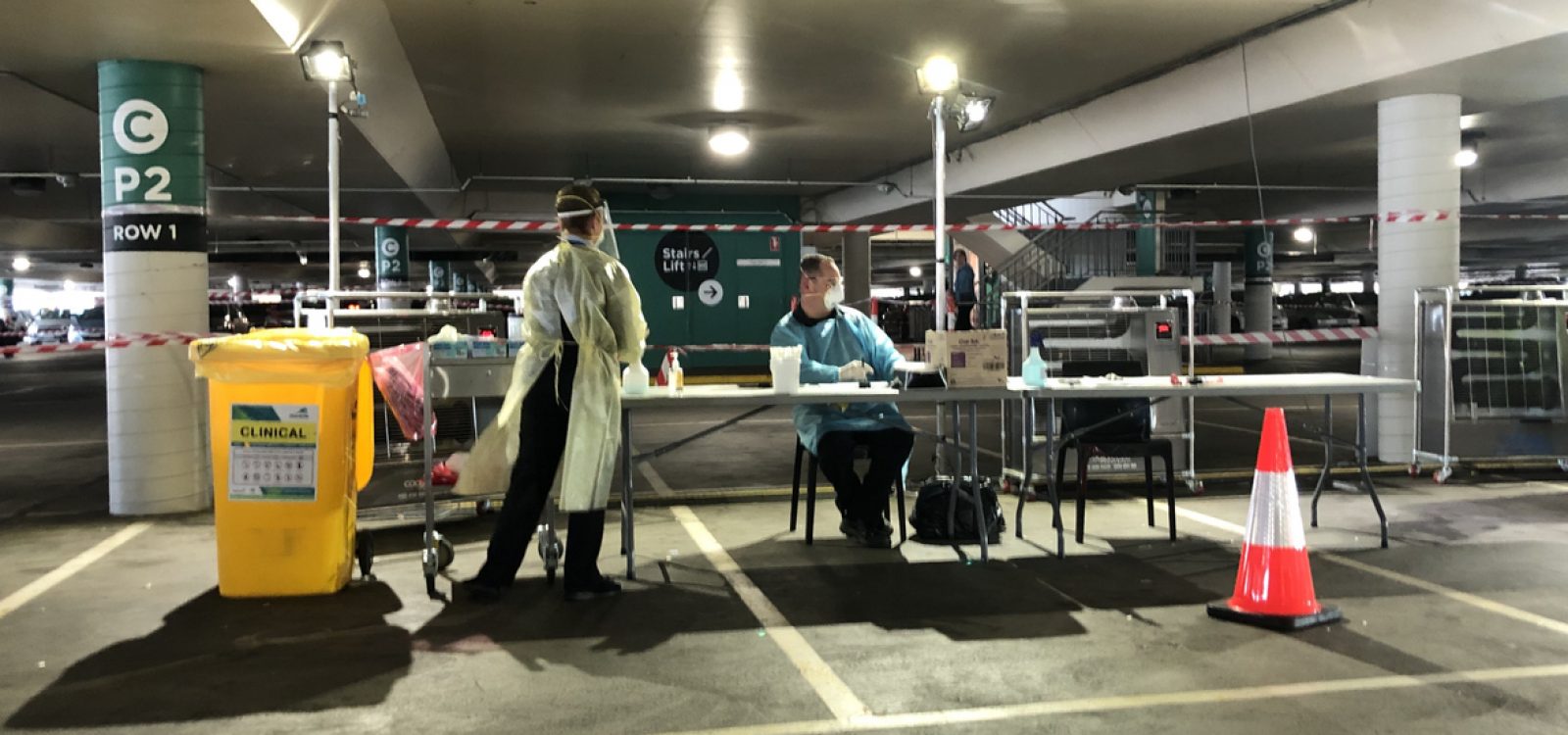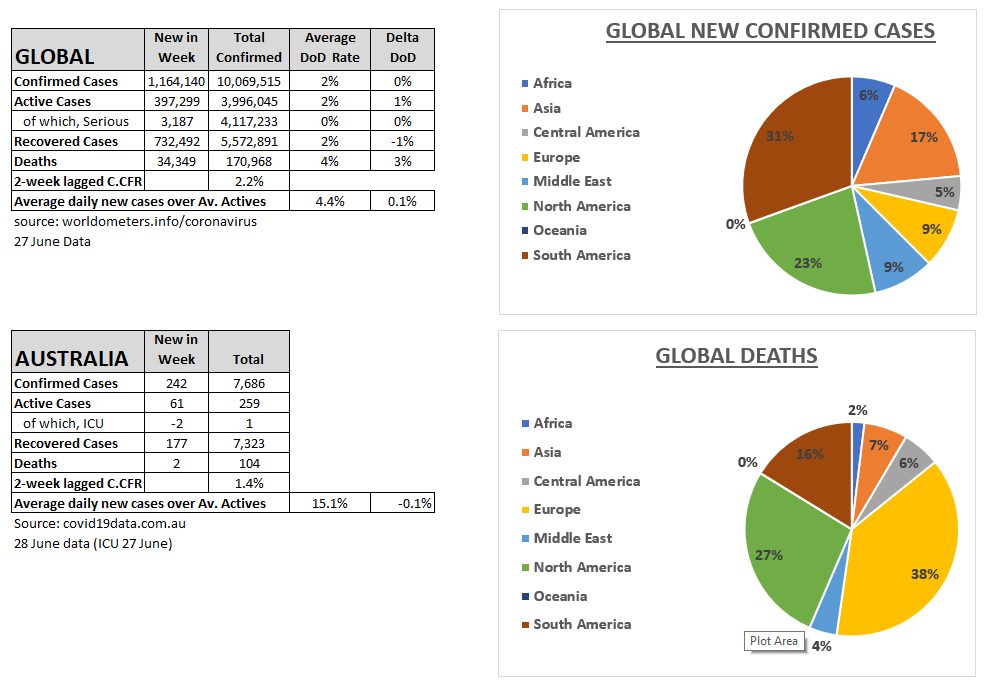
Covid-19 Blog
COVID-19 Monday Roundup 29 June 2020
Global cases reached 10 million today, and global deaths 500,000, so it’s little surprise that the IMF’s global economic outlook deteriorated. Australia was one of few countries to improve in the IMF forecasts, despite record falls in job vacancies and predicted retail spend. A testing blitz is underway in Victoria’s outbreak hotspots, while research suggests bald men should be particularly vigilant to avoid COVID-19.

World Summary – 27 June
- The pandemic accelerated again with new cases growing 11% to pass 1.1 million new cases this week. 44% were in just two countries, USA and Brazil, with a further 9% in India. The US outbreak materially accelerated with over a quarter of a million new cases, up 40% from the prior week. Florida and Texas have reimposed some restrictions to address the surge in those States.
- Deaths eased back slightly to the 7th highest weekly tally in the pandemic.
- 19 (+1, South Africa) countries have outbreaks of 100,000+. India’s outbreak passed half a million, the UK passed 300,000.
- Southern Africa is the fastest growing regional outbreak with a growth rate of 11%, completely dominated by South Africa.
Australia Summary – 28 June
- Total new cases increased to 242. 85% of these (206) were in the well-reported Victoria local outbreaks. While Victoria is re-imposing restrictions amidst a surge in cases, Health authorities say the response is going as planned.
- NSW had 32 (+10) new cases. WA had 3 (+1) and Queensland had 1 (+0). Only four of the NSW cases were not overseas acquired infections, but it does appear that a low level of the virus remains circulating in Sydney.
- Daily testing has risen substantially with ~50,000 tests on five of the last seven days. Discovery rates have risen slightly, again, to 0.07%.
- Provisional mortality data released by the ABS for Q1, shows some indication of excess mortality in Australia.
Key market update
- The IMF’s latest World Economic Outlook Update predicts a deeper recession than its April forecast. The global economy is forecast to contract by 4.9% (vs 3% estimated in April) in 2020. Australia is one of few countries to see an improvement in IMF forecasts, with GDP expected to contract by 4.5% this year (vs 6.7% predicted in April).
- Growth in Australian retail turnover is expected to fall 1.4% in 2020, making it the worst year on record. After a surge in the March quarter, retail spending is expected to contract by 4.0% in the June quarter.
- Australia has maintained its AAA credit rating from Moody’s – one of only ten countries to do so.
- Australia experienced a record fall of 43% in job vacancies in the quarter ending May 2020. Arts and Recreation, Rental and Real Estate, and Accommodation and Food Services were the hardest hit sectors.
- Australia’s arts sector will get access to $250 million worth of grants and loans under a recovery package unveiled by the Federal Government.
- Australia hosted the first Joint call of Finance Ministers with the “Five Eyes” nations – Australia, Canada, NZ, the UK and the US – to discuss economic issues related to COVID-19.
- Reinsurance markets are hardening due to investment market losses and the significant losses expected from COVID-19, which follows years of accumulating catastrophic losses, according to Fitch.
- APRA has requested superannuation funds provide additional data for a new COVID-19 Pandemic Data Collection to enable assessment of the pandemic on the industry and the outcomes being delivered to members.
- ASIC issued yet another article on the rise in scams during the pandemic – this time focussing on investment scams.
- ASIC has asked banks and lenders to work with their customers in the lead-up to September, when COVID-19 loan deferrals and payment schemes come to an end.
New COVID-19 research this week
- Five hundred front line healthcare workers in NSW will join the BRACE trial to discover whether the BCG tuberculosis vaccine reduces the impact of COVID-19.
- This paper summarises the next stage of vaccine development globally, including moving large-scale phase 3 human trials to countries like Brazil, where virus circulation remains high.
- More than 6% of Spanish care home residents are have died of COVID-19 and more than 5% in the UK, the highest rates in Europe.
- Patients in the US may be avoiding hospitals. Between March 11 and April 21, 42% fewer patients were admitted to US Veteran’s Affairs hospitals compared with the preceding 6 weeks, while in the 10 weeks after the US declared a national COVID-19 emergency, emergency department visits for three acute life-threatening conditions – myocardial infarction, stroke and hyperglycemic crisis – declined significantly.
- With significantly lower tuberculosis notifications occurring during lockdowns, modelling suggests interrupted health services could result in at least 110,000 additional tuberculosis deaths in just three countries (China, India and South Africa) over the next five years.
- Modelling suggests that herd immunity could be achieved at far lower rates of population infection than previously estimated, because of differences in transmission rates (R0) between different age groups.
- UK physicians and academics have voiced their concerns about the usefulness of antibody testing for immunity, noting that a positive result does not indicate immunity.
- Two Spanish studies (1,2) found men with baldness were over-represented in hospitalisations for COVID-19. This is consistent with a UK study which showed higher androgen levels are linked to greater susceptibility and severity of COVID-19.
- Pregnant women might be at increased risk for severe COVID-19 illness, but do not appear to have higher mortality. The US CDC has released an updated list of who is at increased risk of severe illness from COVID-19.
- Statistics from UK and Wales indicate security guards, social care workers and nursing as three occupations with relatively higher deaths from COVID-19.
- Researchers have devised a way to decontaminate N95 respirators using household supplies and a microwave.
- Modelling suggests population lockdowns should last for at least 60 days to limit the spread of COVID-19 and help prevent or delay a second, larger wave of infections.
New on the Actuaries Institute website this week.
- Actuaries Digital article: Risk, Uncertainty and Opportunity Learning from the COVID-19 Crisis
This work is licensed under a Creative Commons Attribution-NonCommercial-No Derivatives CC BY-NC-ND Version 4.0.
CPD: Actuaries Institute Members can claim two CPD points for every hour of reading articles on Actuaries Digital.






